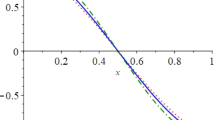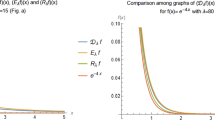Abstract
We refine the classical Lindeberg–Feller central limit theorem by obtaining asymptotic bounds on the Kolmogorov distance, the Wasserstein distance, and the parameterized Prokhorov distances in terms of a Lindeberg index. We thus obtain more general approximate central limit theorems, which roughly state that the row-wise sums of a triangular array are approximately asymptotically normal if the array approximately satisfies Lindeberg’s condition. This allows us to continue to provide information in nonstandard settings in which the classical central limit theorem fails to hold. Stein’s method plays a key role in the development of this theory.
Similar content being viewed by others
References
Barbour, A.D., Chen, L.H.Y.: An introduction to Stein’s method. Singapore University Press, World Scientific Publishing Co. Pte. Ltd, Singapore, Hackensack, NJ (2005)
Barbour, A.D., Hall, P.: Stein’s method and the Berry–Esseen theorem. Aust. J. Stat. 26(1), 8–15 (1984)
Berckmoes, B., Lowen, R., Van Casteren, J.: Distances on probability measures and random variables. J. Math. Anal. Appl. 374(2), 412–428 (2011)
Berckmoes, B., Lowen, R., Van Casteren, J.: An isometric study of the Lindeberg–Feller central limit theorem via Stein’s method. J. Math. Anal. Appl. 405(2), 484–498 (2013)
Berckmoes, B., Lowen, R., Van Casteren, J.: Stein’s method and a quantitative Lindeberg CLT for the Fourier transforms of random vectors. J. Math. Anal. Appl. 433(2), 1441–1458 (2016)
Billingsley, P.: Convergence of Probability Measures. Wiley Series in Probability and Statistics: Probability and Statistics, 2nd edn. Wiley, New York (1999)
Bolley, F.: Separability and completeness for the Wasserstein distance. In: Séminaire de probabilités XLI, Lecture Notes in Mathematics, vol. 1934, pp. 371–377. Springer, Berlin (2008)
Chen, L.H.Y., Goldstein, L., Shao, Q.-M.: Normal Approximation by Stein’s method. Probability and its Applications (New York). Springer, Heidelberg (2011)
Chen, L.H.Y., Shao, Q.-M.: A non-uniform Berry–Esseen bound via Stein’s method. Probab. Theory Relat. Fields 120(2), 236–254 (2001)
Osipov, L.V.: A refinement of Lindeberg’s theorem. Teor. Verojatnost. i Primenen. 11, 339–342 (1966). (Russian)
Feller, W.: On the Berry–Esseen theorem. Z. Wahrscheinlichkeitstheorie und Verw. Gebiete 10, 261–268 (1968)
Loh, W.Y.: On the normal approximation for sums of mixing random variables. Master Thesis, Department of Mathematics, University of Singapore (1975)
Lowen, R.: Index Analysis. Approach Theory at Work. Springer Monographs in Mathematics. Springer, London (2015)
Meckes, E.: On Stein’s method for multivariate normal approximation. In: High dimensional probability V: the Luminy volume, pp. 153–178, Institute of Mathematical Statistics Collection, 5, Institute of Mathematical Statistics, Beachwood, OH (2009)
Nourdin, I., Peccati, G., Réveillac, A.: Multivariate normal approximation using Stein’s method and Malliavin calculus. Ann. Inst. Henri Poincaré Probab. Stat. 46(1), 45–58 (2010)
Rachev, S.T.: Probability metrics and the stability of stochastic models. Wiley Series in Probability and Mathematical Statistics: Applied Probability and Statistics. Wiley, Chichester (1991)
Villani, C.: Topics in Optimal Transportation. Graduate Studies in Mathematics, vol. 58. American Mathematical Society, Providence, RI (2003)
Zolotarev, V.M.: Probability metrics. Teor. Veroyatnost. i Primenen. 28(2), 264–287 (1983). (Russian)
Author information
Authors and Affiliations
Corresponding author
Additional information
Ben Berckmoes is postdoctoral fellow at the Fund for Scientific Research of Flanders (FWO).
Geert Molenberghs gratefully acknowledges financial support from the IAP research network #P7/06 of the Belgian Government (Belgian Science Policy).
Appendix: Proof of Theorem 3.1
Appendix: Proof of Theorem 3.1
We follow [4], Sect. 2. We keep a continuously differentiable \(h : \mathbb {R} \rightarrow [0,1]\), with bounded derivative, fixed, and let \(f_h\) be its Stein transform defined by (6). Also, we put
The following lemma is easily verified. It can be found in, e.g., [1] (pp. 10–11).
Lemma 1
\(f_h\) is twice continuously differentiable, has bounded first and second derivatives, and
The following lemma can be found in [4] (Lemma 2.4). We give the proof for completeness.
Lemma 2
Put
and
Then
Proof
Recalling that \(\xi _{n,k}\) and \(\sum _{i \ne k} \xi _{n,i}\) are independent, \(\mathbb {E}\left[ \xi _{n,k}\right] = 0\), and \(\sum _{k=1}^n \sigma _{n,k}^2 = 1\), we get
The last expression further reduces to
which is easily seen to equal
This finishes the proof. \(\square \)
The following lemma is an application of Taylor’s theorem.
Lemma 3
For any \(a, x \in \mathbb {R}\),
We are now in a position to present a proof of Theorem 3.1.
Proof of Theorem 3.1
For n and \(\epsilon > 0\), we have, by (31), (32), and (33),
which proves the desired result since \(\sum _{k=1}^n \sigma _{n,k}^2 = 1\). \(\square \)
Rights and permissions
About this article
Cite this article
Berckmoes, B., Molenberghs, G. Approximate Central Limit Theorems. J Theor Probab 31, 1590–1605 (2018). https://doi.org/10.1007/s10959-017-0744-6
Received:
Revised:
Published:
Issue Date:
DOI: https://doi.org/10.1007/s10959-017-0744-6
Keywords
- Kolmogorov metric
- Lindeberg–Feller central limit theorem
- Lindeberg index
- Prokhorov metric
- Stein’s method
- Wasserstein metric




